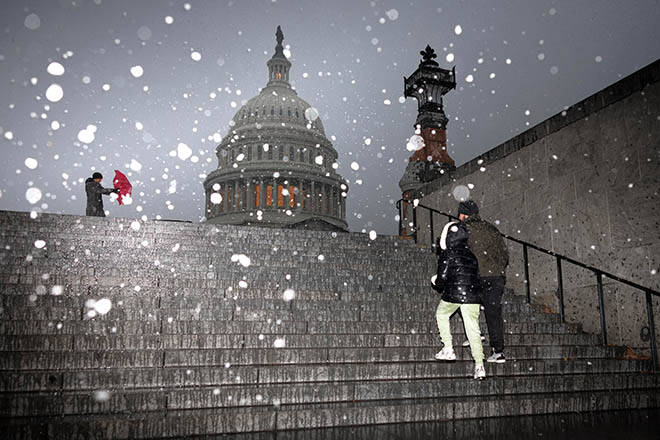Cold snap, winter storms forecast to grip much of U.S.

TOM BRENNER / NEW YORK TIMES
Snow falls near the Capitol in Washington, on Friday. The National Weather Service says a “significant Arctic outbreak” is expected to bring frigid conditions to large swaths of the country this weekend and last into mid-January.
Cold air seeped south of the Canadian border and into the United States on Friday, the start of what the National Weather Service is calling a “significant Arctic outbreak” that is expected to bring frigid conditions to large swaths of the country this weekend and last into mid-January.
While most of the cold was still in southern Canada on Friday, the United States was getting its first wave of it. Chilly air was spreading into the northern High Plains, across northeastern Montana, across northern North Dakota and into northwestern Minnesota, according to the Weather Prediction Center.
In parts of northern North Dakota, temperatures dropped to a bone-chilling minus 10 degrees, with wind chills making it feel like 20 to even 30 degrees below zero.
“It’s quite brutal,” said David Hamrick, a meteorologist with the Weather Prediction Center. “This is just the leading edge, the tip of the iceberg, in terms of Arctic air mass coverage. The cold is coming down in waves.”
Winter storms are also expected to follow in the wake of the plunging temperatures.
Temperatures are forecast to plummet below average for much of the nation, with the most severe cold gripping areas east of the Rocky Mountains and reaching as far south as the Gulf Coast and Florida. Dangerous wind chills are likely across many areas of the Southeast, too.
Don't miss out on what's happening!
Stay in touch with breaking news, as it happens, conveniently in your email inbox. It's FREE!
“This will likely be the most significant cold we have seen in years,” said forecasters at the National Weather Service office in Wakefield, Virginia, adding that the bout of below-normal temperatures “is likely to prevail into mid-January.”
This Arctic outbreak is expected to bring a sustained period of cold weather across the northern Plains, Great Lakes, Midwest and East Coast as well.
The Weather Prediction Center has also warned that a winter storm will begin in the Central Plains on Saturday night. Heavy snow and significant icing are expected to spread east, potentially affecting the mid-Atlantic by early next week.
The current forecast includes a high likelihood of at least 6 inches of snow in parts of the Central Plains and Mississippi Valley, particularly along and north of Interstate 70. Icing is also expected, with sleet and freezing rain forecast for eastern Kansas and the Ozarks. These hazards may extend into the Tennessee and low Ohio valleys through the weekend, and parts of the southern Appalachian Mountains could experience icing by Sunday.
On Sunday and Monday, the risk of severe weather, including strong winds and lightning, could extend to parts of eastern Texas, much of Louisiana and Mississippi, into southern Arkansas and possibly into western Tennessee.
Next week, the Climate Prediction Center’s hazards outlook predicts a high risk of much-below-normal temperatures for the Southeastern United States and portions of the lower Mississippi and Tennessee valleys. Heavy snow is also possible for the Great Lakes region and portions of the Southern Plains through the mid-Atlantic toward the end of the week.
Social media buzz about the chance of 1 foot of snow in Atlanta has drawn some doubts from local forecasters. Dylan Lusk, a meteorologist at the National Weather Service office in Atlanta, wrote that “ingredients to get snow in the south are fickle” and that for such a scenario to unfold, two weather systems would need to converge in a unique way. “Experience tells me not to get my hopes up for snow just yet. Stay tuned to the forecast!”
The National Weather Service echoed this uncertainty in its latest advisory, saying that the timing and trajectory of the storm track will be key factors in identifying areas that could get the most significant weather.
While the possibility of snow next week remains less predictable, forecasters are much more certain about the cold.
“This has the potential to be a fairly significant Arctic outbreak,” said meteorologist Scott Kleebauer with the Weather Prediction Center. “The one thing for sure is that it’s going to get cold, and it’s going to last a fairly long period of time.”
———
This article originally appeared in The New York Times.
© 2025 The New York Times Company



